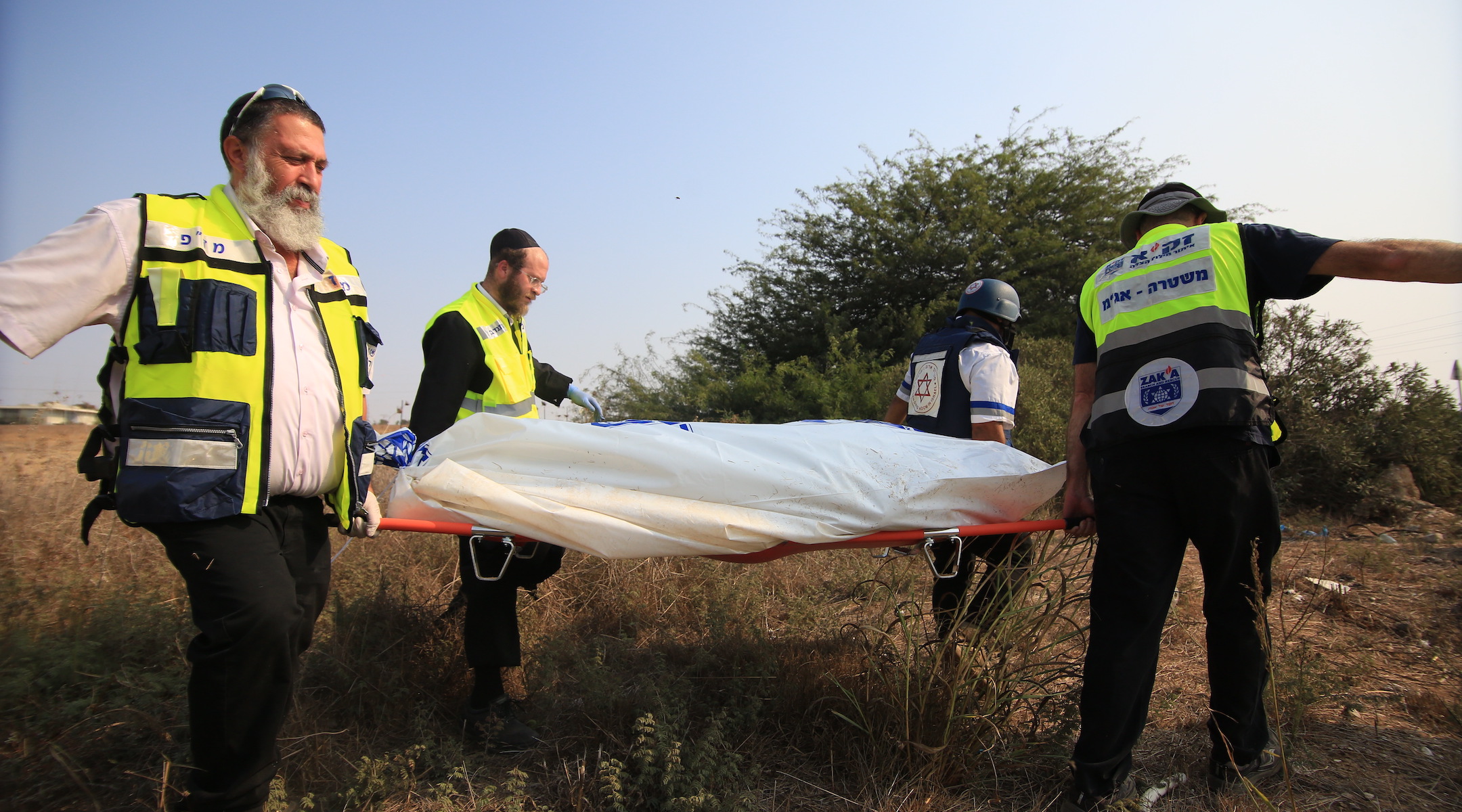Was Hamas’ attack the bloodiest day for Jews since the Holocaust?
The claim, which has begun to be repeated online by journalists and politicians, appears to be accurate

Medical responders carry a body bag in Sderot, Israel, Oct. 8, 2023. (Saeed Qaq/Anadolu Agency via Getty Images)
(JTA) — As the death toll from Saturday’s attack on Israel has mounted, Israelis and Jews around the world have reached for analogies to explain the magnitude of the tragedy, calling the invasion “Israel’s 9/11” or “Israel’s Pearl Harbor.”
Others have tried to put the death toll — now at 700 soldiers and civilians — in perspective by setting it against a far bloodier tragedy: the Holocaust.
“Not since the Holocaust has this large a number of Jews been killed in a single day. Let that sink in,” read an Instagram post from Daniella Greenbaum, a former producer for “The View.” Greenbaum added, “I have no words. My heart is broken. My soul is aflame.”
Eylon Levy, a former spokesperson for Israeli President Isaac Herzog, posted online: “It’s no exaggeration to say yesterday was the darkest day in Jewish history since the end of the Holocaust.” Lazar Berman, a reporter for the Times of Israel, made the same reference: “October 7, 2023 saw the most Jews slaughtered in a single day since the Holocaust.”
The claim appears to be accurate. There have been bloody days in Israel’s history and for Jews around the world since 1945, but none has had a civilian death toll this high. Israeli wars have had higher casualty totals overall, but none has seen this many civilians murdered in a single day.
Israel’s bloodiest war was its War of Independence, which saw 6,000 citizens of the nascent state die in the fighting. But that number is generally counted from No. 29, 1947 into 1949, when the fighting stopped — a period of close to two years. The majority of casualties were soldiers, not civilians.
Saturday’s attack is also being compared to the Yom Kippur War, a conflict in which the Israeli military was taken by surprise on a holy day. Hamas’ attack came one day after that war’s 50th anniversary.
Two of the country’s rival newspapers ran near-identical headlines on Sunday, both declaring that a war had broken out and comparing the Hamas attack to the 1973 war. One read, “The negligence of ’73, the negligence of ’23.”
But while more than 2,000 soldiers died over the course of more than two weeks, the war had a very low Israeli civilian death toll.
שערי העיתונים להיום, 8.10.2023. גלריית השערים המלאה עכשיו באתר. בוקר טוב ☀️ https://t.co/1ByJZtZrvl pic.twitter.com/LSSaYT2bCI
— העין השביעית (@the7i) October 8, 2023
Large-scale murders of Jews have also happened outside of Israel since 1945, though with smaller death tolls than Saturday’s attack. In 1946, a pogrom in Kielce, Poland, killed at least 42 Jews. The bombing of the AMIA Jewish Center in Buenos Aires in 1994, which the American Jewish Committee called “the deadliest antisemitic attack outside Israel since the Holocaust,” killed 85 people.
By contrast, while the figures are still being tallied, it’s clear that at least several hundred Israeli civilians were killed on Saturday in addition to soldiers.
This article originally appeared on JTA.org.
A message from our Publisher & CEO Rachel Fishman Feddersen

I hope you appreciated this article. Before you go, I’d like to ask you to please support the Forward’s award-winning, nonprofit journalism so that we can be prepared for whatever news 2025 brings.
At a time when other newsrooms are closing or cutting back, the Forward has removed its paywall and invested additional resources to report on the ground from Israel and around the U.S. on the impact of the war, rising antisemitism and polarized discourse.
Readers like you make it all possible. Support our work by becoming a Forward Member and connect with our journalism and your community.
— Rachel Fishman Feddersen, Publisher and CEO

























